#senusret ii
Text

Reliefs of Senusret II and Neferhotep I making offerings to Anuket on Sheila. Anuket is the goddess of the cataracts of the Nile and lower Nubia in general, typically worshipped especially at Elephantine near the first cataract.
95 notes
·
View notes
Text
Salima Ikram on the “Floating Pyramid” of Pharaoh Senusret II
“Egypt’s ‘floating’ pyramid mystery solved with 4,000-year-old ‘treasure trove’ discovery
| World | News
By Admin on January 30, 2021
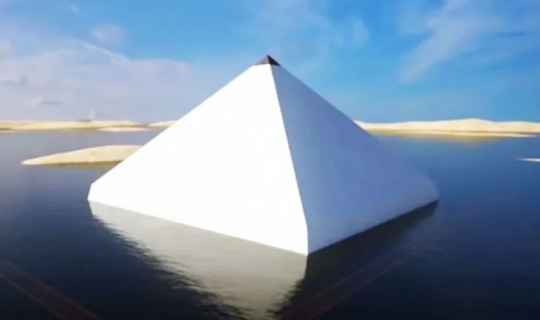
Pyramid of Lahun: Expert explores Egypt’s ‘floating’ pyramid
In the 12th Dynasty of the ancient civilisation, Pharaoh Senusret II ordered for the construction of the Pyramid of Lahun. The fourth ruler of this period in history took a great deal of interest in the Faiyum Oasis region – south of Cairo – and began work on an extensive irrigation system from Bahr Yussef through to Lake Moeris in Middle Egypt. The purpose of his project was to increase the amount of cultivable land in that area and, as a result of his efforts, it would remain the political capital of Egypt through to the 13th Dynasty.
When he died in 1878 BC the pharaoh was buried in his monument and now, the Science Channel’s ‘Unearthed’ documentary has unravelled the secret to his incredible architecture.
The series explained: “Built around 1870 BC, it’s a mighty monument clad in gleaming limestone that rises 160 feet above the desert.
“At the top, a black granite capstone makes a connection to the heavens.
“Next to it, a smaller pyramid – for the pharaoh’s queen – and eight stone mastaba memorials.
How the pyramid may have looked 4,000 years ago (Image: YOUTUBE/SCIENCE CHANNEL)
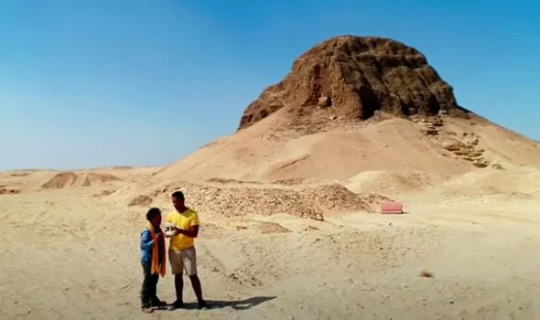
Experts visited the ancient monument (Image: YOUTUBE/SCIENCE CHANNEL)
“It was all enclosed by a huge mud-brick wall. The complex was said to be surrounded by water, seemingly floating in the desert.
“It stands in Egypt’s vast western desert. This is a fertile area of the desert known as the Faiyum Oasis.”
Leading archaeologist Dr Salima Ikram revealed her theory on how the pharaoh created the illusion that his pyramid was floating.
She said: “What a sight it must have been for people, to look at something like that – this mountain of a pyramid encircled by water.
“We’re in the middle of a desert, but in the distance, you can see there is lots of greenery and vegetation.

How the ancient site may have once looked (Image: YOUTUBE/SCIENCE CHANNEL)
“The fact that there is a lush oasis here means there is a constant supply of water.”
During the documentary, experts used drone footage to track what they believed to be the route of the ancient waterways.
The narrator explained: “The pyramid is built about 10 miles from the River Nile.
“In ancient times, the annual floods inundate the barren land with life-giving water and minerals.
“A huge canal constructed by an earlier pharaoh also channels water from the mighty river to the Faiyum.
“Salima thinks that the Nile and the canal are not the only sources of water.”
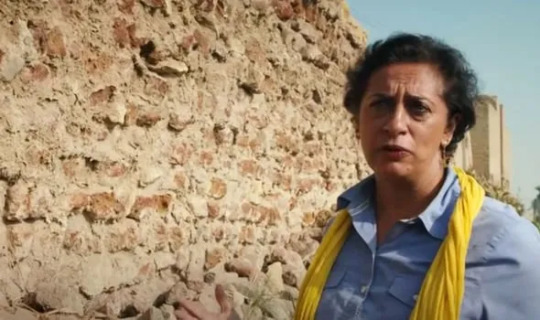
Salima Ikram identified a modern dam (Image: YOUTUBE/SCIENCE CHANNEL)
Dr Ikram then put forward her theory.
She added: “This large water channel that connects to the Nile is one of the main sources of water for this whole area near the pyramids.
“I wonder what it would have been like 4,000 years ago when it was much wetter, it rained much more and there were even powerful floods.
“The amount of water here makes it a bit curious that someone should choose their site to build a pyramid.
“Senusret II could have been buried with his father several miles to the north of here, but he actively came and sought out and chose this place so he must have had a very good reason to do that.”
Visiting a nearby dam, Dr Ikram explained the crucial role she believes it played in ancient Egypt.
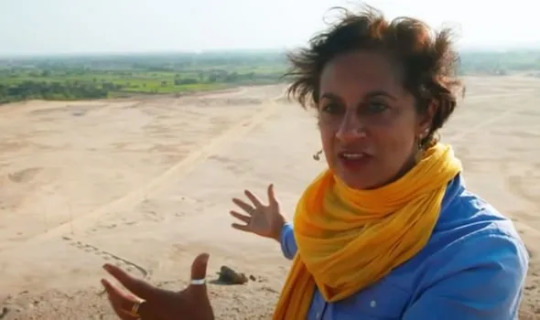
Dr Ikram said the pharaoh’s work played a crucial role (Image: YOUTUBE/SCIENCE CHANNEL)
She added: “What’s really interesting is if you go all the way down, this dam is built on the foundation of Senusret II’s dam.
“This is the first dam ever built in the Faiyum and he used it to tame this region and turn it into an agricultural treasure trove.”
And the series detailed how it played a key role thereafter.
The narrator continued: “The pharaohs before Senusret dug out a waterway from the Nile to the Faiyum, creating a massive lake and oasis.
“Senusret himself builds dikes and irrigation channels to distribute water to the surrounding desert.
“Drawing water from the oasis, Senusret creates 17,000 acres of new farmland near the lagoon and he builds his pyramid right next to it to commemorate his achievement and life’s work.” “
Source: https://www.moradabadpages.com/egypt-s-floating-pyramid-mystery-solved-with-4-000-year-old-treasure-trove-discovery-world-news/
9 notes
·
View notes
Text

Statue of a priest named Sebek-em-hat, About 1780 B.C.E.
Limestone, Polychrome
Egyptian
------------------------------------------
The standing statue of Sebek em hat can be identified as a leader of a group of priests in the temple of a deified king at Heliopolis (near Cairo).
Inscribed, Back Pillar: A boon which the king gives to Anubis, Lord of Hen, that he may give a goodly burial to the Ka of the Phyle-Leader, Sebek-em-hat, begotten of Sebek-em-hat, born of Sit-hat-hor, the justified.
Inscribed, on Base: A boon which the king gives to Ra-Atum, Lord of Heliopolis, and to Osiris, Lord of Busiris, the Great God, Lord of Abydos, that he may give an invocation consisting of bread and beer.
Inscribed, Detached Base: To the Ka of the Phyle Leader in the temple of Kha-kheper-Ra (Senusret II) in Heliopolis.
-Description by The Detroit Institute of Art
3 notes
·
View notes
Text
12 Facical Recreations Of Africa's Ancient Egyptian Pharaohs/Figures Based On Their Respective Sculptures
The 12 facial recreations of Africa’s ancient Egyptian pharaohs and figures based on their respective sculptures offer a captivating glimpse into the past. From the regal visage of Ahmose Nefertari to the serene countenance of Queen Tiye, each reconstruction brings history to life. The majestic presence of Amenhotep III and the enigmatic charm of Nefertiti are captured with remarkable precision.…
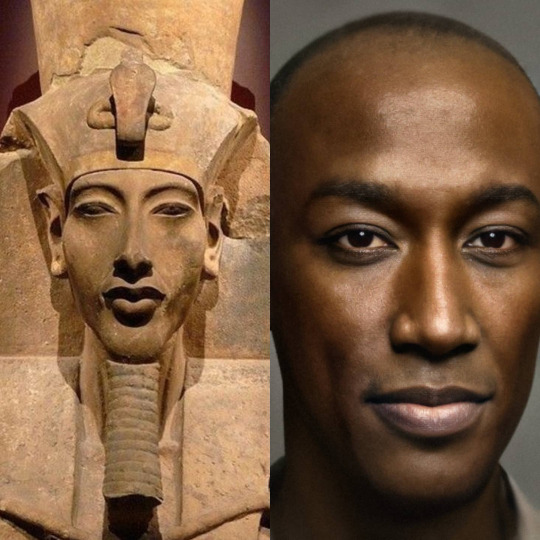
View On WordPress
#12 Ancient Egyptian Pharaohs Facical Recreations#African History#Ahmose Nefertari#Akhenaten#Amenemhat III#Amenhotep III#Ancient Egyptian Pharaohs Facical Recreations#Ancient Egyptians#ancient egyptians history#Djoser#Narmer#Nefertiti#Queen Tiye#Rameses II#Sahure#Senusret III#Tutankhamen
0 notes
Text

Ancient Egyptian girdle, made from cowrie shells, gold, carnelian, feldspar, and copper-silver alloy, belonging to the Princess Sithathoryunet, thought to have been the daughter of the 12th Dynasty ruler Senusret II (r. 1897-1878 BCE). Found in the tomb of Sithathoryunet (BSA Tomb 8) in the Fayum; now in the Metropolitan Museum of Art.
#art#art history#ancient art#Egypt#Ancient Egypt#Egyptian art#Ancient Egyptian art#12th Dynasty#Middle Kingdom#jewelry#jewellery#girdle#metalwork#gemwork#Sithathoryunet#Metropolitan Museum of Art
260 notes
·
View notes
Text

The Life Force is Imagination powered by Desire.
Image: Uraeus of Senusret II, Middle Kingdom, 12th Dynasty, ca. 1897 BCE.
39 notes
·
View notes
Text
Photo by Ahmed Sameh

Mentuhotep II & Senusret III
“About 200 years is the time difference between them, The Egyptian Museum was their only meeting place!”
—— Ahmed Sameh
7 notes
·
View notes
Photo

Okay #Egyptologists and ancient civilization researchers, what are your ideas and theories about this "sarcophagus" inside the pyramid of Senusret II, located in the Fayoum Oasis. This granite box is very well preserved and super beautiful. It's also not level. The top slopes down at a slight but noticeable angle (see the second image). Does anyone know the exact degrees? More importantly, does anyone have a guess as to WHY it has a slope? The whole chamber is different than most other pyramids I've been in. It's arched, and the tunnel/entrance is normal people height. So weird. #TempestOfEgypt #khemet #kmt #Fayoum #pyramid
Original IG Post
Link in bio (if needed): Linktree
3 notes
·
View notes
Text
BLACK WARRIORS, KINGS AND GODS | AfricanAmerica.org
BLACK WARRIORS, KINGS AND GODS
AUSAR (OSIRUS)
Ausar is one of the most important figures in the history of world civilization. According to ancient knowledge, Ausar (Osirus) contributed to the creation of Khemitic (Egyptian) civilization through a series of new programs that began long before the Great Flood. The prehistoric civilization of Ta-Seti was more advanced than Egypt and existed before Egyptian civilization by three thousand years (TIME MAGAZINE, 1999).
Ausar also travelled to the East and established settlements in India including a City called Nysa after the Nysa of Egypt (read "African Presence in Early Asia," edt. by Runoko Rashidi and Ivan Van Sertima, Transaction Publications. Also read "Susu Economics," pub. by 1stbooks Library, www.1stbooks.com
Ausar is credited for the inventiontion and improvement of forms of arts, sciences, literature, culture and many other arts and sciences.
KHEKPERE SENUSRET (CECROPS)
Khekpere Senusret known as "Cecrops" by the Greeks is said to have founded the City of Athens and contributed to the creation of Greek civilization before the Greek tribes migrated from Central Europe among a number of Europeans who migrated Southerward between 1700 B.C. and afterwards.
Senusret was also a warrior who established a colony on the Black Sea and maintained thousands of African troops from Egypt in the region. The Greek writer Herodotus describes these Africans as Colchians and compares them to the original Negro Egyptian people.
As recently as the 1940's, there were still remnants of African people living in the region of Armenia and the Black Sea region.
AHMOSE 1, THE PHARAOH WHO LIBERATED EGYPT FROM THE HYKSOS INVADERS
Ahmose 1 liberated Egypt from the Semitic Hyksos invaders after about two hundred years of brutal and oppressive rule. The Hyksos, who were pastoralist Semites from the Southwest Asia region invaded Egypt. After proper planning and military skill, Ahmose drove out the Hyksos armies. Yet, more Semites and others including the Assyrians, Babylonians, Libyans, Persians, Greeks, Romans, Arabs and Europeans entered into Egypt as the centuries went by, changing the very gene pool of Egypt from Negroid African to being today more mixed in the North and purer Black Egyptian in the Southern part.
Tarharka Nubian Pharaoh of the 25th Dynasty, about 650's B.C.
ODE TO TARHARKA
I
The God has come from the lands upriver
to liberate and rule downriver,
the God so blessed by Re the Sun,
tall and well built, hue as the night so strong,
all the userpers fled out west,
these petty kings were not our guests,
for centuries invaders ruled in Khem,
ravaged our motherland, all them.
Chorus
Tarharka mighty God and King,
Swept from the South with lightening sting,
his armies destroyed all the invaders,
from lands beyond the sand and of mauraders,
who placed themselves on our throne,
claimed our history and claimed our homes,
but we the sons and daughters of Nubia-Cush,
no one shall make us slaves, not us.
II
And so he looked out to the Khuru Sea,
the barbarians assembled in the Polynese
and so his men they came from East,
and said be ready for the Nenivese,
The Sons of Asshur plan to attack,
and its our duty to push them back,
and keep Nubia-Cush safe from all of them,
and spread our power beyond Khem.
III
Year thirty-five thirty-nine after Solar Calendar,
we heard the thundering of the invader
their horses swept through the Sea of Sand
came across the Sinai one million,
but we Nubian-Cushites of the Gods,
used our minds and defeated the hordes.
and let our descendants know as well
in or lands no Shemites shall dwell.
Tarharka and the Nubians ruled Egypt during the 25th Dynasty. Tarharka was one of the most important Pharaohs in Egyptian history because he and those in his Dynasty restored Egyptian culture and greatness back to Egypt after Egypt had been dominated by a numnber of foreign rulers and the pure Egyptian culture and religions were being lost. Tarharka was a powerful Pharaoh who was controlled the Mediterranean region. He also established a Nubian presence in Spain and the Nubians maintained trade into the Atlantic during the 25 Dynasty. See more on the Nubian Dynasty at http://community.webtv.net/nubianem
NARMER, UNITED THE TWO KINGDOMS OF EGYPT ABOUT 3500 B.C.
Narmer was one of the early Egyptian Pharaohs and played a major role in uniting the Delta region with the rest of Egypt as early as 3500 B.C.
SAMOURY TOURE "THE BLACK NAPOLEON OF THE SUDAN" FOUGHT THE FRENCH FOR TEN YEARS BEFORE BEING CAPTURED AND EXILED TO CONGO FROM HIS HOMELAND SENEGAL
CUSHITE PHARAOH ASPELTA
MODERN SOUTH SUDANESE CUSHITE WARRIORS FIGHTING TO FREE THEIR NATION FROM SEMITIC COLONIALISM, ATROCITIES AND GENOCIDE
IS WAR IS REAL, IS WAR FOR ALL?
Tiny tots with minds to know,
saying Daddy, Daddy, is it so,
is war for real, is war, is real?
now Daddy, Daddy what's the deal?
and what's a Dad to tell his own,
so many suffer, so many have gone,
Tiny tots with minds of their own,
why do the tv (media) treat the people less grown,
asking Daddy, Daddy is war for all?
so to save the oppressed and heed the call?
Sudan, Mauritania and West Papua,
destroying, enslaving those who are other,
religious expanders on the go,
seeing a religious empire, but some say no.
And so today the braves they fight,
no one will enslave them, its their right,
Dinkas, Nubas, Papuans, Mandinkas
fighting against the northern invaders,
and do we wonder if its just,
those who want freedom from this thrust?
Nubia-Cushites (South Sudan) driven down to the dust
Shall rise again with our help they must.
WAR OF WORDS
Talk-show mouth porn is bad
drinking corn is bad
smoking gives lunng cancer
males just stay lowcount under
ork give you worms
dorks they have yearns
some women have it all
Black men must rise against the fall,
welfare destroys all families
childcare no, men work for their babies
men with good ways get the ladies
loud-mouthed women stay single Sadies,
disarm, that arm and can't harm
his marm, says homework for school marm,
read "Susu Economics," and "A History of
Racism and Terrorism, Rebellion and Overcoming,"
both from 1stbooks.com and barnesandnoble.com,
great works on Aframericanism and freedom
war here, war there fifty years of terror in Sudan,
for there, for where, no one wants to be dragged to the ground,
justice, just them invading our lands and ravaging our women,
iterracial rape, taking African women to the North to be bread,
biracial children calling them "Semites" when they are Africans instead,
Dinkas, Nubas and Nubians say enough of this evil and this dread,
talk shows, flock follows, hosts on cupcakes and jewel addiction,
walk those, mock those, their Tokyo Rose-type outtakes is cruel repitition,
pornography, warmorphology, tricknology, armageddon, religion,
promoted by,
photography, phallisology, accused of being warmongers promoting armageddon to bring holocausity.
....but its happening in Sudan, Mauritania, West Papua and Latin America.
ethnic clensing and genocide is when they destroy or confine all the males, elevate the females and then ravage her,
make her believe she has made it and have no need for the Black men who saved her
from Ahmose to Toussaint to Nat Turner fighting and defeating all the barbarians who crossed to invade our sisters.
more poems at http://community.webtv.net/paulnubiaempire
NUBIAN QUEEN AND SON SEES DESTRUCTON OF ROMAN FORT AT ASWAN BY NUBIAN SOLDIERS
A number of Nubian-Cushite queens called Ka'andakes (Candaces) ruled Nubia-Cush just before the birth of Christ. This queen and her son along with the Nubian-Cushite Army kept the Romans out of Nubia-Cush. In this scene, they are witnessing the burning of the Roman Garrison in Aswan. The Roman army were defeated in Nubia and never attempted to invade that nation again.
Today however, the Nubian-Cushites (South Sudanese) are dealing with a similar situation of foreign cultural and religious control and domination of their lands from a culture and people who also now dominate Egypt. Nubia-Cush was also the first nation on earth to be the victims of Semitic terrorism through the use of constant attacks on their territory, enslavement, destruction of their cities and persistant warfare. Emperor Kalydosos of Nubia-Cush defeated the Arab armies during the 600's A.D., yet later on the Semites were able to infiltrate Nubia-Cush in trickles and in waves and established themselves in the North and using the scheme of taking African women, while declaring the children part of the Semitic culture. This policy is totally against the African idea that no foreign race or group can claim a child or children born to African women on African soil as part of the invaders ethnic or racial group.
Today, the Nubian-Cushites continue to fight for their lands and to maintain their religions and cultures.
ANCIENT WARRIORS FROM BENIN, WEST AFRICA WITH CORAL HELMETS, SHIELDS AND JAVLINS
West Africa was and still is one of the core areas of prehistoric civilization on planet earth. The prehistoric Zingh Empire of the Southwestern Sahara was located in the region of Mauritania, Mali, Burkino Faso, Senegal and the vincinity. The Zingh Empire was the first regional empire to use the red, black and green standard. According to sources, the Zingh Empire existed about 15,000 years ago and included a region from West Africa to Turkey. This empire existed at a time when the Sahara was still covered with lakes, had plant and animal life, vegetation and teamed with human cultures. (Read about the Zingh Empire in the book, "Susu Economics: The History of Pan-African Trade, Commerce, Money and Wealth, " pub. by www.1stBooks.com
more:
http://community-2.webtv.net/Nubianem2/BLACKWARRIORSKINGS/page2.html
11 notes
·
View notes
Text
Crown of Princess Blanche
The Bohemian Crown is famously the oldest surviving royal crown to have been in England, dating back between 1370 to 1380. It most likely belonged to Queen Anne of Bohemia, wife of English king Richard II.
Crown of Saint Wenceslas
Part of the Bohemian crown jewels, the gemstone encrusted head adornment was created in 1346 for Holy Roman Emperor Charles IV.
Monomakh’s Cap
The golden skullcap is the oldest crown kept in the Kremlin, originating from the late 13th or early 14th century.Legend says that the medieval crown was given by the Byzantine Emperor Constantine Monomachus to the prince of Kiev, Vladimir Monomakh. Other theories suggest that it was given to Moscow by Uzbeg, Khan of the Golden Horde.
Holy Crown of Hungary
One of two Byzantine crowns that have survived to the present day, the oldest elements of this beautiful head adornment are believed to be from the 11th century.
Imperial Crown of the Holy Roman Empire
Confusingly even though the headpiece is known as Charlemagne‘s Crown, it was made for Otto the Great in the 10th century. Created in the Byzantine style for the Holy Roman Emperor.
Crowns of Silla
During the early Middle Ages, parts of the Korean peninsula was ruled by the Silla Kingdom.
The Iron Crown
This may be the oldest Christian crown in history, made between the 4th and 5th century. Kept in Monza Cathedral, there is no clear knowledge for whom it was originally created.
Ptolemaic gold diadem
Following the death of Alexander the Great, Egypt was ruled by the Greek Ptolemaic dynasty.
The Diadem or Crown of Princess Sit-Hathor Yunet
The ancient head adornment is the oldest crown on this list, belonging to the daughter an Ancient Egyptian King of the 12th Dynasty (possibly Senusret II).
0 notes
Text

Diadem of Princess Sithathoriunet
When Flinders Petrie and Guy Brunton explored the shaft tomb of Princess Sithathoriunet in 1914 (located in the funerary complex of Senusret II at El Lahun), they found little apart from her red granite sarcophagus and a set of canopic jars, the vessels which accompanied each burial to house the internal organs. Then they discovered a niche in the wall that had been plastered over.
Inside were five boxes containing Sithathoriunet's jewelry, a mirror, razors and pots for cosmetics. Most of the objects from this tomb are now on display in the Metropolitan Museum of Art, New York. The masterpiece in this collection is a diadem with a circular band of gold decorated with a uraeus or rearing cobra at the front and fifteen rosettes. It also has two gold plumes and six bands of gold hand down from the diadem.
Middle Kingdom, 12th Dynasty, reign of Senusret II, ca. 1897-1878 BC. Now in the Egyptian Museum, Cairo. JE 44919
166 notes
·
View notes
Text
https://en.wikipedia.org/wiki/Sesostris
Sesostris (Greek: Σέσωστρις), also transliterated as Sesoösis, or Sesonchosis,[1] is the name of a legendary king of ancient Egypt who, according to Herodotus, led a military expedition into parts of Europe. Tales of Sesostris are probably based on the life of Senusret I , Senusret III and perhaps other Pharaohs such as Sheshonq I[1] and Ramesses II.[2]
Herodotus also relates that when Sesostris defeated an army without much resistance he erected a pillar in their capital with a vulva on it to symbolize the fact that the army fought like women.
1 note
·
View note
Photo

The Golden Uraeus of The King Senusret II | Middle Kingdom, 12th Dynasty 𓋹𓂀𓆗𓃥𓅓𓆤𓆣𓅃𓃠𓆃 𝕰𝖌𝖞𝖕𝖙 🇪🇬😍👑💎⚰ #Egypt #History #Culture #Tourism #مصر #Egitto #Egipto #Египет #埃及 #ეგვიპტე #मिस्र #Egiptas #Єгипет #Civilization #Egito #Ägypten #Եգիպտոս #Αίγυπτος #Egyiptom #Mısır #Egipt https://www.instagram.com/p/Ce4H0XaMJ2t/?igshid=NGJjMDIxMWI=
#egypt#history#culture#tourism#مصر#egitto#egipto#египет#埃及#ეგვიპტე#मिस्र#egiptas#єгипет#civilization#egito#ägypten#եգիպտոս#αίγυπτος#egyiptom#mısır#egipt
0 notes
Link
0 notes
Text
Radamis II Nile Cruise
Radamis II Nile Cruise
If You Go To Egypt You want to experience one of the top Nile Cruise Holidays and stay with World Tour Advice to try something new while travelling on the Nile River.
Along with visiting priceless artefacts and structures in Egypt (The Land of History), you have the opportunity to take in the grandeur of the Nile River by taking a Felucca Nile Cruise, exploring Luxor and Aswan, and more with the help of World Tour Advice.
Nile Cruises,Create unforgettable memories while visiting Egypt to experience the charm of the past You have the opportunity to take part in one of the most amazing and fascinating Nile Cruises in Egypt with Ibis Egypt Tours on the Luxor to Aswan Cruise. investigate Luxor Sightseeing Visit Karnak Temples where you can explore many elements that date to different eras, similar to Luxor Temple where you can enjoy seeing The Pylon of King Ramses II and The Colonnade of King Amenhotep II. This complex started from the reign of King Senusret I (the Middle Kingdom) and continued to the Ptolemaic period.
Nile river cruise Holidays,Visit Hatshepsut, then sail to Edfu to explore The Second Large Temple After Karnak Temple and Known as (Temple of Hours), then Continue Sailing to Kom Ombo to Have Amazing Time in This Wonderful Double Shared Temple, Then Enjoy Aswan Attractions. Explore The Great Hypostyle Hall That Contains 134 Column in Different High, Scout to The Valley of the Kings The Royal Necropolis That Contains K.V 62 of King Tutankhamun, Then Visit Explore The High Dam that Protects Egypt from Flood and Drought, similar to the Philae Temple that dates to the Roman Period and is dedicated to the Egyptian goddess Isis, the Giver of Life and mother of Kings.
Day 1: Embarkation in Luxor
Meet and assist by World tour advice Tours representative upon your arrival at Luxor airport, train station or Luxor hotels. Then a direct transfer by private air-conditioned vehicle to board MS Movenpick Radamis II Nile cruise. Enjoy your first Lunch meal a board, then meet your tour guide, start a guided tour to visit the biggest temples ever erected in the world Karnak complex and Luxor Temples. Back to your ship for afternoon tea and dinner,at night free time to walk in the city or Sound and light show in Karnak temple, overnight stay on board in Luxor.
Day 2: Luxor Nile Cruise Tours
Breakfast on board the Radamis II Nile cruise boat, followed by a guided tour to Luxor West Bank, go to visit the Valley of the Kings, Hatshepsut Temple at El Deir EL Bahari, ruins of Amon Hotep III mortuary temple including the Colossi of Memnon, Back to the ship for lunch and an afternoon tea during sailing towards Edfu. Dinner and overnight a board MS Swsiss In Radamis II in Edfu.
Day 3: Edfu & Kom Ombo Nile Cruise Tours
Breakfast on board the MS Radamis II Nile cruise ship, then your tour guide will take you in a guided tour by horse carriage to go to visit Horus Temple in Edfu, Back to the board, sailing to the south to Kom Ombo. Enjoy Lunch on board. A guided tour to visit the temple shared by the two gods Sobek and Haroeris ( Kom Ombo temple ). Sailing to Aswan, dinner and overnight stay.
Day 4: Aswan Nile Cruise Tours
Enjoy your Breakfast on board the MS Radamis II Nile cruise, then enjoy an early tour to visit Aswan sightseeing, Aswan High Dam, Hatshepsut Unfinished Obelisk in the very old Egyptian granite quarries, tour to the majestic Philae Temple on one of Aswan beautiful islands, you will arrive it by sailing by a small motor boat,then visit the Botanical Garden on Kitchner island. Overnight stay on board in Aswan.
Day 5: Aswan – Disembarkation
Disembarkation after breakfast aboard MS Radamis II cruise. If you want to add an optional tour to visit Abu Simbel from Aswan
Transfer to Aswan airport, train station, Aswan Hotels.
Itinerary 3 Nights
Day 1 Aswan - Embrace Aswan and Nubia culture - Nile Cruise Holidays
Embarkation to Radamis II Nile cruise ship before Lunch, start an amazing tour to scout the fabulous High Dam, the Granite Quarries where you will see the unfinished obelisk of Hatshepsut, Feast your eyes by watching the glory of Philae Temple, sailing on the river Nile by Felucca around Kitchener's Island & Agha Khan, finally return back to your Radamis II Nile Cruise, Relish your yummy lunch on board Afternoon tea, Enjoy music in the cruise lounge, Dinner and overnight on board Radamis II Nile Cruise.
Day 2 Kom Ombo Edfu - Nile Cruise Holiday
Now it is time not only to taste the flavor of a tasty breakfast on board, but also to feast your eyes at the time your Cruise Sailing to Kom Ombo, scout the striking Temple of Kom Ombo, The temple is shared by two gods Sobek & Haeroris in Kom Ombo proceed sailing to Edfu, Unleash your inner adventure and visit the ravishing Temple of Horus in Edfu visit the Temple Lunch will be served during sailing time to Esna afternoon tea, Dinner on board, Enjoy Galabeya Party show, Overnight in Luxor.
Day 3 Luxor West Bank tours - Nile cruise holiday
Enjoy your yummy tasty breakfast on board, sailing from Esna to Luxor, Unleash your soul during your excursions to unblock secrets of Pharaohs, Tour to Valley of the Kings, Next visit to Valley of the Queens, proceed to the Temple of Queen Hatshepsut, known now with the name of El-Deir El-Bahary, finally Worldtouradvice tours guide will escort you back to Radamis II Nile Cruise, Lunch included on board, Afternoon Tea, Belly Dance Show, Enjoy music in the lounge, dinner and overnight on board Radamis II Nile Cruise in Luxor.
Day 4 Luxor East Bank Tour
Disembarkation from Radamis II Cruise after tasting the flavor of your yummy breakfast on board, it is the time to beguile your eyes by a tour to the fabulous Karnak Temple with its huge Pillars hall known as the forest of pillars, then stir t scout Luxor temple, then worldtouradvice will transfer you to Luxor airport or railway station for final departure
Radamis II faciities
Sailing Schedule time :
All Mondays: Radamis II start sailing from Luxor to Aswan for 4 nights/5 days
All Fridays: Radamis II start sailing from Aswan to Luxor for 3 nights/4 days
Technical Specifications:
The Radamis II ship Length is 72m
The RadamisII ship Width: 13.7m
The ship Height: 11.7m
The ship Weight: 600 tons
• Smoke Detector System Panel
• 5 decks
Radamis II cruise ship purvey a total of 65 stunning luxury cabins of approximately 21 square metres, 4 cabines from them are family cabins and other four are deluxe suites of about 28 square metres.
All the cruise ship Cabins Contain the following:
• Air-condition with private temperature controls
• A large window, Floor to ceiling panoramic window enabling you to see the Nile scenery during sailing time,
• Private wc equipped with a bathtub, hairdryer and shaving sockets for 220V power supply
• LCD
• In-house video and music channels
• Wi-Fi
• Two Life jackets
• Escape map
• Non-smoking cabins are available on request.
Fourth deck D: 28 cabins
Restaurant deck C: 16 cabins
Lounge deck B: 16 cabins
Lower deck A: 14 cabins
Restaurant , Bar, Lounge/disco, Gem, Library,Massage room, Laundry and
Ironing service, business center, bazaar
Includes
Meet & assist services upon arrival & departure by world tour advice tour Representative
Direct private transfer from any destination in Luxor or Aswan to the cruise ship and return ( First and last day in the cruise holiday )
Accommodation aboard 5 stars Nile cruise on full board basis
All Nile cruise excursions along the Nile cruise journey planned by world tour advice
Day trip to visit the coplex of Karnak temple and Luxor temple in Luxor East bank
Day tour to scout Valley of the Kings & Hatshipsut temple in Luxor West bank
Day trip to visit Edfu temple as per Radamis II Nile cruise itinerary
Day tour to visit Kom Ombo temple as per Radamis II cruise itinerary
Day trip to visit Aswan highlights as following Philae temple, the High Dam & the unfinished obelisk
Day tour to visit Elephantine island & Botanical Gardens in Aswan
Entrance fees to all the sights between Luxor and Aswan as mentioned in our Nile cruise itinerary
Professional Egyptologist tour guide for all tours aboard cruise
Service charges and all applicable taxes
Excludes
International flight
Egypt Entry Visa
Optional Tours
Tipping Kitty
For more info
Website
Mobile and what’s App:
002 01090023837
#Radamis II Nile Cruise Tours#Radamis Nile cruise Holidays#Nile river cruise Holidays#Radamis II Luxor cruise#Radamis Nile Cruise Packages#Nile Cruises#deluxe nile cruise
0 notes
Text
@cairo-top-tours @lelesam96 @lailaessam2910 @sohilaesam @hagerkamal @travelegyptinstylewithme
#cairo top tours#délicieux#château#safari#tourisme#sable#rivière#luxe#expérience#Égypte ancienne#explorer#pyramides#chameau#plongée#voyage#désert#croisière#magnifique#éblouissant#beauté#top tours du caire
0 notes